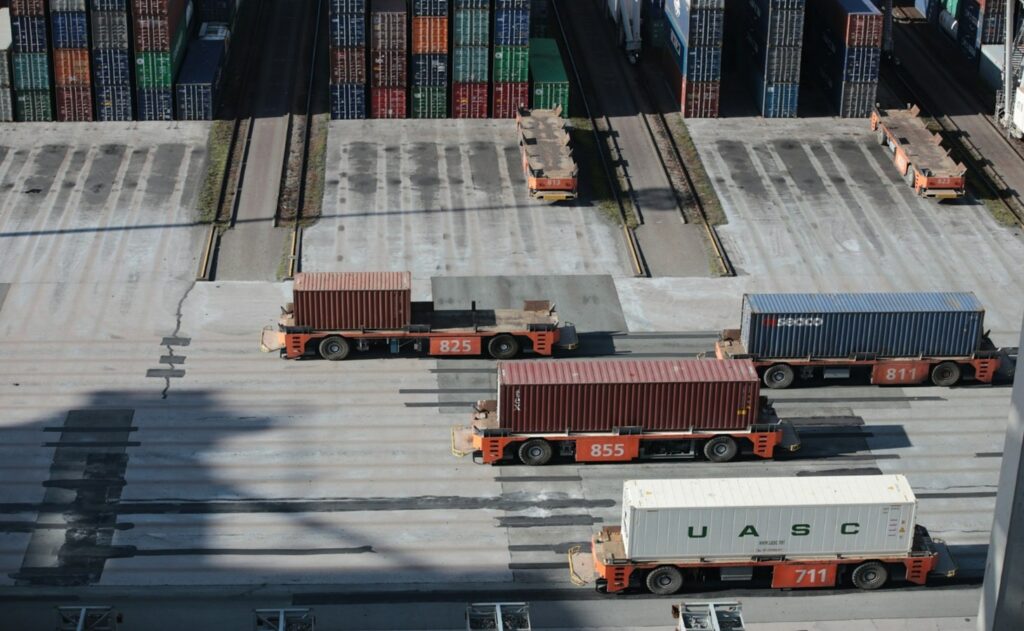
Transforming Logistics Through ESG: A Pathway to Sustainability
12 mins. read | 12th May 2025
Environmental, Social, and Governance (ESG) considerations are no longer peripheral—they are rapidly becoming central to how businesses operate across sectors. In the logistics industry, which sits at the intersection of supply chains, trade, infrastructure, and technology, ESG is not only about reducing emissions or improving reporting. It is about redefining how logistics networks are designed, financed, operated, and monitored. As regulatory frameworks tighten and customer expectations shift, logistics players who embed ESG deeply will unlock long-term resilience, access to capital, and reputational advantage.
Why ESG in Logistics is Gaining Traction?
The logistics sector is one of the largest contributors to global greenhouse gas emissions—transport alone accounts for around 20–25% of global CO₂ output. Moreover, social aspects like fair labour practices in warehouses, driver welfare, and local community impacts are gaining attention from both regulators and investors. The governance side is equally critical: ESG transparency, anti-corruption policies, and ethical sourcing are now prerequisites in global supply chains.
Logistics companies can no longer afford to see ESG as a reporting burden; it is a core business concern that affects profitability, risk exposure, and long-term value creation.

Global Momentum: How Countries Are Driving ESG in Logistics
Across the globe, governments are deploying a mix of regulations, incentives, and standards to push ESG into the logistics mainstream. The European Union, known for leading climate policy, is moving decisively with the Corporate Sustainability Reporting Directive (CSRD). Effective January 2024, this directive broadened the scope of non-financial reporting, requiring companies to provide detailed ESG disclosures, including on climate risks, supply chains, and human rights practices. Complementing this is Germany’s Supply Chain Due Diligence Act (LkSG), which places direct responsibility on companies with over 1,000 employees to ensure their entire supply chains uphold human rights and environmental protection. Adding teeth to these measures is the Carbon Border Adjustment Mechanism (CBAM), which levies tariffs on imports based on their carbon intensity, directly impacting logistics providers involved in cross-border trade.
Meanwhile, the United Kingdom aligns its ESG approach with global frameworks, notably the ISSB (International Sustainability Standards Board) guidelines. The UK government is preparing to roll out Sustainability Reporting Standards (SRS) for listed companies, fostering greater alignment in disclosures. Additionally, it has announced its version of the CBAM, which is expected to be in force by 2027. This will place a carbon cost on imported goods, encouraging decarbonisation at home and abroad.
In India, ESG regulation is evolving rapidly. The Securities and Exchange Board of India (SEBI) has mandated the top 1,000 listed entities to adopt the Business Responsibility and Sustainability Report (BRSR) format for ESG disclosures. While this represents a significant step toward corporate accountability, implementation is challenging. Reporting difficulties—especially in tracking ESG metrics across complex supply chains—have led SEBI to extend deadlines and revise frameworks. Nevertheless, this move signals a strong policy intent to embed ESG into Indian corporate DNA.
Malaysia is also stepping up. The CEO Action Network (CAN), spearheaded by Bursa Malaysia and major industry leaders, has turned ESG into a boardroom conversation, particularly for logistics companies. Focused on achieving the country’s emissions reduction goals, the initiative encourages firms to build robust governance structures and adopt greener operations, such as shifting to electric fleets or digitising supply chain visibility.
Together, these examples reflect a rising tide of ESG momentum—driven not only by compliance but by the recognition that sustainable logistics is key to economic and environmental resilience.
Challenges in Implementation and Reporting
1. Fragmented standards and regulations
One significant barrier is the fragmentation of global reporting standards. Companies must navigate frameworks like GRI, TCFD, and SASB—often with overlapping or conflicting requirements. This confusion makes consistent and comparable reporting challenging for global logistics firms.
2. Quality Data Collection
Data collection is another major hurdle. Logistics operations span multiple geographies and vendors, making it difficult to capture accurate data, primarily indirect greenhouse gas emissions, which include indirect impacts from third-party suppliers and transportation partners. Most firms still lack robust digital tools or standardised methods to track such data effectively.
3. Cost Pressures
Cost pressures are equally real. Green technologies, sustainable infrastructure, and ESG compliance audits demand upfront investment—often without immediate ROI. This is especially hard on SMEs, which lack access to green financing or government subsidies. As a result, many continue to prioritise short-term efficiency over long-term sustainability.
4. Greenwashing Risks
Greenwashing—falsely portraying ESG credentials—poses a growing reputational risk. With investors and customers increasingly ESG-conscious, misleading claims can backfire quickly. Regulators are beginning to crack down, but the challenge remains widespread.
5. Technological Gaps Among Suppliers
While multinational logistics players can afford blockchain traceability and AI-driven monitoring, their smaller vendors often lack the digital infrastructure to comply, creating weak links in the ESG value chain.
On-the-Ground Barriers to ESG Reporting
Real-world challenges further complicate ESG implementation. The sheer complexity of supply chains, often spanning several countries and involving multiple intermediaries, makes mapping ESG risks and dependencies a herculean task. Supplier resistance is another issue, especially in regions with low ESG awareness or regulatory pressure. Without incentives, vendors are unlikely to embrace change voluntarily.
Additionally, consumer expectations can create a paradox. While sustainability is increasingly valued, demand for ultra-fast delivery and low-cost products persists, pushing logistics companies to cut corners on ESG priorities. Lastly, the lack of standardised metrics—for example, on biodiversity impact or social inclusion—makes it hard to measure ESG progress consistently.
Real-World Impact: What’s Working
Despite these challenges, successful examples glimpse ESG’s transformative potential. DHL, for instance, has committed over €7 billion toward climate-neutral logistics by 2030, investing in electric delivery vehicles, sustainable aviation fuel, and smart warehousing. The company’s ESG integration has improved environmental outcomes and enhanced brand equity and access to ESG-focused investment funds. Maersk, a leader in shipping and logistics, is moving aggressively towards green methanol-powered vessels and aims for net-zero emissions by 2040. In India, Tata Motors and Delhivery deploy electric delivery fleets in last-mile logistics, aligning business efficiency with ESG goals. On the port side, Port of Antwerp-Bruges uses blockchain to enhance traceability in green logistics, combining governance and environmental objectives with innovation.
These success stories demonstrate that ESG, when embedded strategically, improves operational performance, reduces regulatory risk, and attracts long-term capital. In contrast, firms that treat ESG as a box-checking exercise often struggle with incoherent strategies, reputational risks, and missed opportunities for innovation.
Why ESG Matters: The Long-Term Business Case
For logistics companies, ESG is not just about regulatory compliance—it’s a strategic lever for long-term competitiveness, resilience, and profitability. In an industry built on networks and trust, strong ESG performance enhances stakeholder confidence, from investors and regulators to customers and employees.
Financially, companies with strong ESG credentials enjoy better access to capital. Global investors are increasingly aligning portfolios with sustainability metrics, and ESG-rated firms often see lower cost of capital, favourable lending terms, and higher valuation multiples. According to studies by MSCI and BlackRock, ESG leaders outperform laggards over time, particularly during market downturns.
Operationally, ESG drives efficiency. Decarbonising fleets, reducing packaging waste, and improving warehouse energy use directly reduce costs. Safety initiatives and diversity policies improve employee retention and productivity, which is critical in a chronic labour shortage sector.
Strategically, ESG shields firms from future disruptions. Climate change, policy shifts, and social unrest are no longer distant risks—they’re boardroom issues. Companies that integrate ESG today build resilience against tomorrow’s shocks. Furthermore, as supply chain transparency becomes a norm, ESG maturity will be decisive in contract wins and global partnerships.
“ ESG is not a cost—it’s a catalyst. Companies that treat it as a compliance checklist will fall behind. Those that embed it as a growth strategy will lead.”
The Road Ahead:
The future of logistics lies in sustainability—not as a buzzword but as a business imperative. As the regulatory and consumer landscape evolves, logistics firms must embrace ESG not just to stay compliant but also to stay competitive.
The long-term business case is clear: ESG strengthens brand trust, reduces costs, attracts investment, and builds resilience against future disruptions.
Case studies from UPS to IKEA, and policy shifts from Germany to Malaysia, show that when ESG is deeply integrated into corporate DNA, it yields efficiency, equity, and endurance. The journey may be complex, but the direction is clear: logistics must move goods and global progress towards a greener, fairer, and more transparent world.
Digital ESG systems will be indispensable in the coming years, using AI, IoT, and blockchain to track real-time emissions, energy consumption, and ethical practices across supply chains. Collaborative frameworks among logistics providers, shippers, and regulators will be crucial to standardising ESG metrics and reducing duplication. Green finance instruments—such as sustainability-linked loans and ESG bonds—will play a larger role in enabling transformation, especially for capital-heavy infrastructure upgrades.
Another crucial area will be capacity building. ESG integration demands new capabilities in procurement, legal compliance, data analytics, and stakeholder communication. Building internal ESG literacy and governance frameworks will be vital for consistency and credibility. ESG is moving beyond risk mitigation—it is now a lever for innovation, stakeholder trust, and long-term economic advantage.
However, implementing an ESG framework is no small feat. It requires overcoming significant challenges, including cost pressures. ASCELA is committed to providing the strategic guidance and market insights that companies need to navigate this shift and capitalise on a seamless transition successfully
At ASCELA, we recognise that ESG is no longer an optional add-on—it is fundamental to the future of logistics. As a strategy consulting firm working closely with logistics developers, infrastructure authorities, and governments, we support clients at every step of their ESG journey.

Author:
Nishtha Saha
Principal Consultant
Strategic Advisory- Mobility and Supply Chain
Share via:

